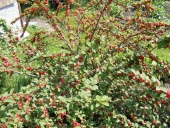I plant food forests for the future here on Manitoulin Island in Lake Huron. I want to be able to feed my local village, Tehkummah, Ontario, in the coming hard times when world large scale commercial food systems have failed.
I have planted over 110 nut trees,plus lots of fruit trees/ shrubs and support trees in windbreaks, nitrogen fixers and a varied herbaceous layer. The total number of trees and shrubs is now well over 1,000.
My farm is in zone 4b, but there are still many nuts that can grow here. I have hazels,heart nuts ( aka Japanese Walnuts), Black Walnuts, ultra northern pecans, bitternut hickory ( better named yellow bud hickory), shagbark hickory, Korean pine nuts, ginko ( including 1 female named variety, King of Dongting), Burr oaks, Low tanin oaks from a breeding program that are a mix of white oak,burr oak ,etc., and 1 experimental Javids Iranian Almond( which is budded out for the first time right now).
The hickory family ( pecan,shagbark, and yellow bud) , Korean pine nuts, oaks, and ginkos are very slow to come into bearing, and i may not live to see nuts from them( I am 69), but once they start, they will literally produce nuts in large quantities for hundreds of years. Enough to feed a village.





